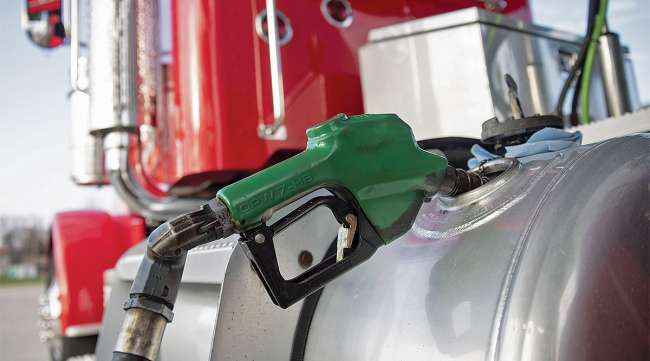Senior Reporter
Diesel Increases 0.4¢ to $2.428 for First Increase in Four Weeks

[Stay on top of transportation news: Get TTNews in your inbox.]
The average price of diesel increased for the first time in four weeks, inching up four-tenths of a cent nationally to $2.428 per gallon on Aug. 10, according to the Energy Information Administration’s weekly report.
At the same time, the price of a barrel of oil remained in the $41 range.
With the increase, the nationwide price of trucking’s main fuel is 58.3 cents a gallon less than it was a year ago.

Connectivity is changing trucking today and into the future, including how it could enable electric and self-driving trucks. Host Seth Clevenger talks with two experts from Penske Transportation Solutions, Bill Combs and Samantha Thompson. Hear a snippet, above, and get the full program by going to RoadSigns.TTNews.com.
The national average cost of gasoline, meanwhile, dropped by 1 cent to $2.166 a gallon, 45.8 cents per gallon cheaper than a year ago.
EIA expects that gasoline prices will gradually decrease through the rest of the summer to reach an average of $2.04 per gallon in September before falling to an average of $1.99 per gallon in the fourth quarter.
It forecast U.S. regular gasoline retail prices will average $2.23 per gallon in 2021, compared with an average of $2.12 per gallon in 2020.
The average cost of diesel increased in five of the 10 regions EIA surveyed. The average price declined in four regions and remained flat in one.
The largest jump in diesel prices was in the Rocky Mountain region, where diesel increased by 2.6 cents per gallon. Even with the increase, the price of diesel there is 57.1 cents less expensive than it was a year ago.
The smallest jump was two-tenths of a cent in New England to $2.633 per gallon, and diesel is 44 cents less expensive there than a year ago.
EIA said 33% of the retail price of a gallon of diesel stems from the cost of crude oil.
EIA’s #Gasoline and #Diesel Fuel Update provides weekly updates of retail motor gasoline and on-highway diesel fuel pump prices. https://t.co/R9nDY5CK73 #gasprices #dieselprices pic.twitter.com/HIAJxs6khz — EIA (@EIAgov) August 11, 2020
West Texas Intermediate crude “is scraping higher but it doesn’t breakout and run. It does seem like we are in this period of sideways [pricing] with a bit of an upward bias,“ Phil Flynn, senior market analyst for The Price Futures Group, told Transport Topics.
With diesel, Flynn said it looked like the inventory builds in recent weeks due to the “decimation of demand from the novel coronavirus pandemic are bottoming out a little bit on price and supply sides.”
A recent big uptick in global manufacturing is picking up and is good for freight demand, he added. “Yet, refiners are not focusing on producing as much diesel because there isn’t any kind of money there,” he said.
Adding complexity to the markets are persistent concerns about a second wave in the pandemic, he said.
Meanwhile, Matt Smart, director of fleet sales at Cumberland International Truck, said the third generation of its C10 ultra fuel-efficient longhaul Class 8 is soon to be in the hands of customers to test.
“Our goal is to build a production-ready super truck, of sorts. It has the capability to get to 10 miles per gallon under the right circumstances relative to the fleet and their operations,” he said.
U.S. average on-highway #diesel fuel price on 8/10/2020 was $2.428/gal, UP 0.4¢/gallon from 8/03/2020, DOWN 58.3¢/gallon from year ago https://t.co/p676W1iLAE #truckers #shippers #fuelprices pic.twitter.com/2yGHYFInzy — EIA (@EIAgov) August 11, 2020
He said the truck was most effective in enabling increased fuel efficiency in longhaul van operations.
This new truck will come with the 2021 Cummins X15 Efficiency Series, “which opens up an entirely new suite of parameters that we can lean on to maximize fuel economy, including predictive shifting and on-ramp boost.”
The engine is paired with the Eaton Cummins Endurant HD 12-speed automated manual transmission.
“This truck is evolutionary, not revolutionary,” Smart said. “It is a three-year newer version of what was a very efficient truck and brings all the new technology that we and our partners have today,” he said, including tires, components, engine oil and aerodynamic devices.
EIA forecasts U.S. liquid fuels consumption will average 18.9 million barrels a day in the third quarter of 2020 — down 1.8 million b/d year-over-year — before rising to an average of 20 million b/d in 2021. Although the 2021 forecast level is 1.6 million b/d more than EIA’s forecast 2020 consumption, it is 400,000 b/d less than the 2019 average.
West Texas Intermediate crude futures on the New York Mercantile Exchange closed at $41.94 Aug. 10 compared with $41.01 per barrel Aug. 3.
EIA expects high inventory levels and surplus crude oil production capacity will limit upward price pressures in the coming months, but as inventories decline into 2021, those upward price pressures will increase.
EIA expects crude production to average 11.3 million b/d in 2020 and 11.1 million b/d in 2021, down from 12.2 million b/d in 2019.
Associate News Editor Dan Ronan contributed to this story
Want more news? Listen to today's daily briefing:
Subscribe: Apple Podcasts | Spotify | Amazon Alexa | Google Assistant | More




